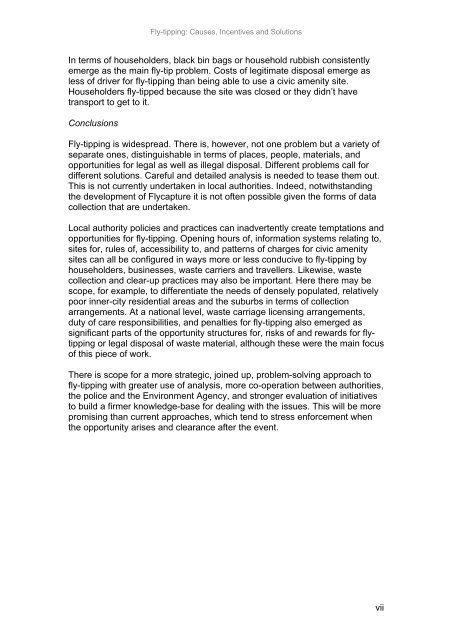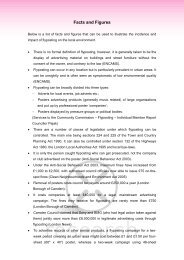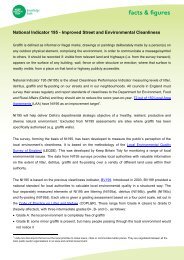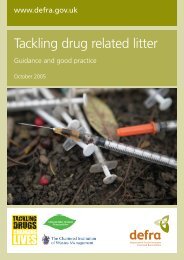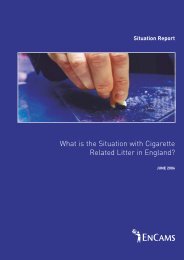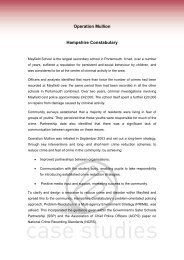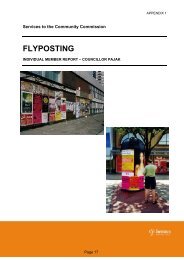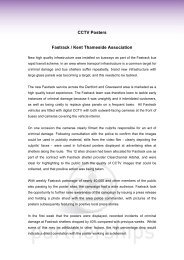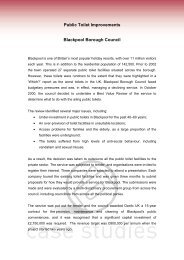Fly-tipping: Causes, Incentives and Solutions - Keep Britain Tidy
Fly-tipping: Causes, Incentives and Solutions - Keep Britain Tidy
Fly-tipping: Causes, Incentives and Solutions - Keep Britain Tidy
You also want an ePaper? Increase the reach of your titles
YUMPU automatically turns print PDFs into web optimized ePapers that Google loves.
<strong>Fly</strong>-<strong>tipping</strong>: <strong>Causes</strong>, <strong>Incentives</strong> <strong>and</strong> <strong>Solutions</strong><br />
In terms of householders, black bin bags or household rubbish consistently<br />
emerge as the main fly-tip problem. Costs of legitimate disposal emerge as<br />
less of driver for fly-<strong>tipping</strong> than being able to use a civic amenity site.<br />
Householders fly-tipped because the site was closed or they didn’t have<br />
transport to get to it.<br />
Conclusions<br />
<strong>Fly</strong>-<strong>tipping</strong> is widespread. There is, however, not one problem but a variety of<br />
separate ones, distinguishable in terms of places, people, materials, <strong>and</strong><br />
opportunities for legal as well as illegal disposal. Different problems call for<br />
different solutions. Careful <strong>and</strong> detailed analysis is needed to tease them out.<br />
This is not currently undertaken in local authorities. Indeed, notwithst<strong>and</strong>ing<br />
the development of <strong>Fly</strong>capture it is not often possible given the forms of data<br />
collection that are undertaken.<br />
Local authority policies <strong>and</strong> practices can inadvertently create temptations <strong>and</strong><br />
opportunities for fly-<strong>tipping</strong>. Opening hours of, information systems relating to,<br />
sites for, rules of, accessibility to, <strong>and</strong> patterns of charges for civic amenity<br />
sites can all be configured in ways more or less conducive to fly-<strong>tipping</strong> by<br />
householders, businesses, waste carriers <strong>and</strong> travellers. Likewise, waste<br />
collection <strong>and</strong> clear-up practices may also be important. Here there may be<br />
scope, for example, to differentiate the needs of densely populated, relatively<br />
poor inner-city residential areas <strong>and</strong> the suburbs in terms of collection<br />
arrangements. At a national level, waste carriage licensing arrangements,<br />
duty of care responsibilities, <strong>and</strong> penalties for fly-<strong>tipping</strong> also emerged as<br />
significant parts of the opportunity structures for, risks of <strong>and</strong> rewards for fly<strong>tipping</strong><br />
or legal disposal of waste material, although these were the main focus<br />
of this piece of work.<br />
There is scope for a more strategic, joined up, problem-solving approach to<br />
fly-<strong>tipping</strong> with greater use of analysis, more co-operation between authorities,<br />
the police <strong>and</strong> the Environment Agency, <strong>and</strong> stronger evaluation of initiatives<br />
to build a firmer knowledge-base for dealing with the issues. This will be more<br />
promising than current approaches, which tend to stress enforcement when<br />
the opportunity arises <strong>and</strong> clearance after the event.<br />
vii


